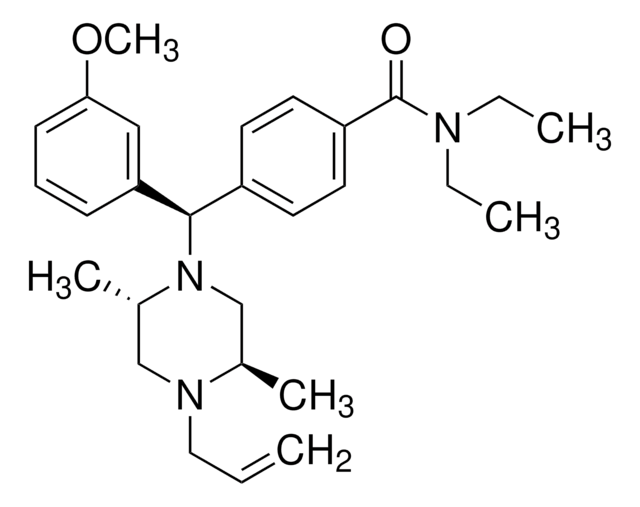G0544
GR 103691
≥98% (HPLC), solid
Sinônimo(s):
4′-Acetyl-N-[4-[4-(2-methoxyphenyl)-1-piperazinyl]butyl]-[1,1′-biphenyl]-4-carboxamide
About This Item
Produtos recomendados
Ensaio
≥98% (HPLC)
forma
solid
cor
white
solubilidade
DMSO: soluble >5 mg/mL at 60 °C
originador
GlaxoSmithKline
temperatura de armazenamento
2-8°C
cadeia de caracteres SMILES
COc1ccccc1N2CCN(CCCCNC(=O)c3ccc(cc3)-c4ccc(cc4)C(C)=O)CC2
InChI
1S/C30H35N3O3/c1-23(34)24-9-11-25(12-10-24)26-13-15-27(16-14-26)30(35)31-17-5-6-18-32-19-21-33(22-20-32)28-7-3-4-8-29(28)36-2/h3-4,7-16H,5-6,17-22H2,1-2H3,(H,31,35)
chave InChI
JARNORYOPMINDY-UHFFFAOYSA-N
Informações sobre genes
rat ... Htr1a(24473)
Aplicação
- inducing effect on prepulse inhibition (PPI)
- suppressive effect of motor behavior in rats
- inhibitory effect on chemotaxis in newly excysted juvenile C. sinensis (CsNEJs)
Ações bioquímicas/fisiológicas
Características e benefícios
Informações legais
Código de classe de armazenamento
11 - Combustible Solids
Classe de risco de água (WGK)
WGK 3
Ponto de fulgor (°F)
Not applicable
Ponto de fulgor (°C)
Not applicable
Equipamento de proteção individual
Eyeshields, Gloves, type N95 (US)
Certificados de análise (COA)
Busque Certificados de análise (COA) digitando o Número do Lote do produto. Os números de lote e remessa podem ser encontrados no rótulo de um produto após a palavra “Lot” ou “Batch”.
Já possui este produto?
Encontre a documentação dos produtos que você adquiriu recentemente na biblioteca de documentos.
Nossa equipe de cientistas tem experiência em todas as áreas de pesquisa, incluindo Life Sciences, ciência de materiais, síntese química, cromatografia, química analítica e muitas outras.
Entre em contato com a assistência técnica








